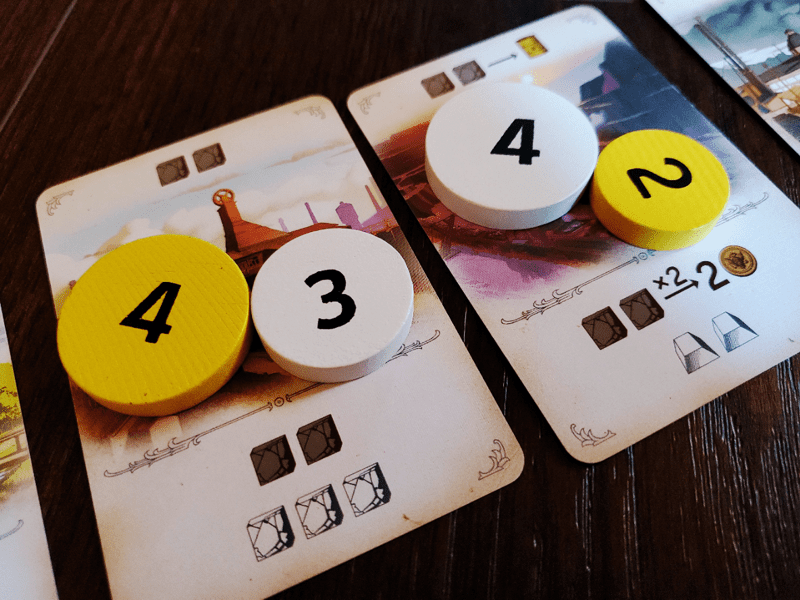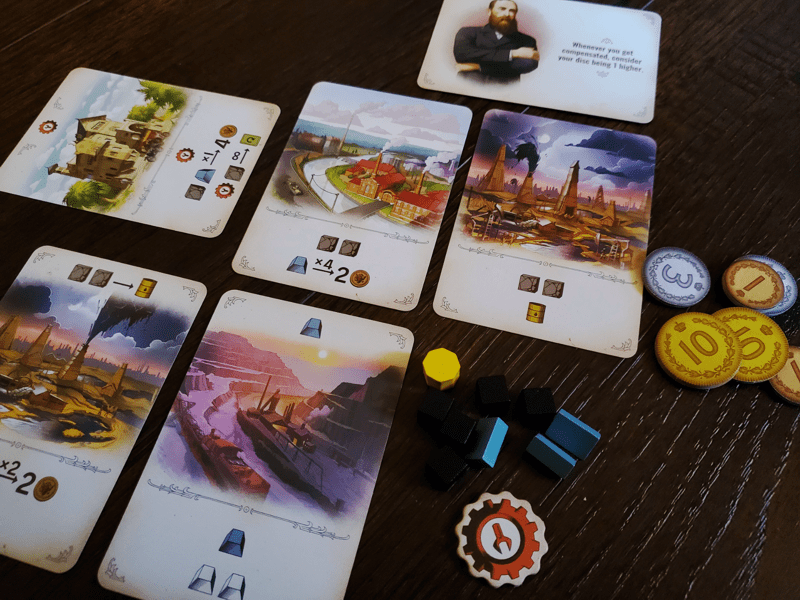I would be lying if I failed to admit the superficial fact that my interest in Furnace had everything to do with its box. Publishers take note: I will make every effort to acquire games whose covers boast a prominent use of white space, sometimes without regard to the game inside. I’m not even ashamed to say so. Tokaido? Yes. Topiary? Absolutely. Petrichor? You bet. Furnace, the engine-builder from Ivan Lashin (Smartphone, Inc.), has one of the more striking boxes around.
The young pencil-drawn industrialist has a scowl that speaks more of ambitious resolve than it ever could of joyful living. Below his shoulder, his silhouetted body blends seamlessly into an early 20th century factory complex. With a splash of indicative color, a manufactured glow emanates from what would be his heart were he not governed by the drive to build a prosperous empire. Power lines extend to and from the image as if he is strung up, supported and animated by the product of his greed.
The white space isn’t really white, and how could it be amid the polluted skies and even more polluted ambiance within? The effect is potent. I half expected a dirty cloud to rise from inside as I lifted the lid for the first time.

Certain boxes just work. And while they may speak clearly enough to get a game into my collection, it takes a solid game to stay. Furnace is making a strong case.
A System Built to be Gamed
Furnace stands out because of the Auction. Each of the four rounds begins with an Auction phase in which players will place their discs labeled 1 through 4 atop the available cards. Discs cannot be placed if the result is a duplicate number or color. This restriction alone is interesting, but it’s really only the beginning.
Every factory card is useful in two capacities. To the winner, the card joins the personal family of factories for use in the Production phase. The two effects on the bottom enter the repertoire for use once each round. To the loser, the effect on the top serves as compensation for the lost Auction. Each player with a losing disc in the fight claims the effect multiplied by the number on the disc.

Oh, and the Auction cards trigger in order from left to right, meaning the victories and losses must be calculated properly to give each effect its maximum heft.
Kudos to Ivan Lashin for this system. It is drop-dead gorgeous in play. I’ve watched grown men sweat over the decision-making process. I’m talking real sweat. Kind of gross, really. There are loads of games that involve trying to win auctions. There are far fewer with an equal-if-not-greater emphasis on trying to lose auctions. In any given round, there will be a card—maybe two—with the particular effect that best suits a given player’s strategy on the bottom. In every round, half or more of the available cards will boast the sort of compensation that will have multiple players drooling to milk a loss for all its worth.
It’s often easy to lose with that lowly disc bearing a 1. I say often and not always because it’s also entirely possible to place that lowly one anticipating a loss, only to then accidentally win the Auction and be stuck with a less-than-desirable bottom effect and no compensation. A four always wins, but there are really no other certainties in the Auction. To the loser go the spoils, I suppose.

A Game Like Many Other
In the simultaneous Production phase, Furnace falls into a more mundane pattern as the various factory bits come to life. Gain coal, steel, or maybe oil. Trade coal for steel, steel for oil, or oil for coal. Trade some combination of resources for money—the ultimate goal. Upgrade cards to unlock that second bottom effect. Use every card once in the most efficient order and turn those industrial goods into enough coins to win.
The distinction in the Production phase lies in the fact that cards are available only once each round, with each effect occurring in the order it appears on the card. No jumping from one card to another and back again to max out the possibilities. And yet, managing the best card order each round allows for a hint of paralyzing liberty.

In a more challenging variant, cards must be placed irrevocably into the order after winning an Auction and must then trigger in order every round. This variant places an even greater emphasis on the Auction—on winning the right cards and obtaining the necessary compensation to feed the deterministic engine. The execution is far less taxing than laying the rails.
Output
Furnace is, in a word, robust. The Auction is so unique and immensely enjoyable that the more common Production phase is entirely forgivable. Every tick and twitch of every player around the table is fodder for the decision-making process. Did she just tap her four? Where is she looking next? When I picked up my three, did he let out a little smirk? He needs that coal card. They’re all staring at the oil, I know it!
The internal monologue is no less tense, examining every possible crease and fold of the strategic plan. Should I drop a four on my favorite card or start jockeying for compensation? Do I even have a favorite card? The one or the two? The three? They’ll never let the three fly. The two. No, the one. Right, the two.
To be honest, the lighter and usually more obvious Production phase, while a potential weakness in the design, is a kindness—a gift to offset the agonizing bids regardless of the variant chosen. There is only so much to be done in the Production phase. The game is in assembling the right combination via the Auction. There is a hint of efficiency required in Production, but the struggle is negligible.
There are extras. The Ability cards that skew the game further towards asymmetry carry strategies all their own, and they are a seamless and worthy addition. The slight differences in each player’s starting factory also contribute to planning. In combination they provide a wealth of possibilities every time Furnace hits the table. The dummy player that accompanies and interferes with the two-player affair is a fit mechanism. In fact, it only works because the artificial player gets in the way. The die keeps that a distinct possibility on every turn. The extras are obviously well tested to maintain the dirty atmosphere. And the round marker is oddly satisfying—how often do you say that?
For anyone who struggles with the suspicion of simultaneous play, know that Furnace will arouse discomfort. When the Production dust settles, a quick glance around the table reveals that, all of a sudden, everyone emerges from the lack of oversight with a mound of coins and little accountability as to where it came from. But what is industrial competition built on if not a healthy dose of trust? Hmm…
When I spot the weathered white-ish box on the shelf from across the room, I wouldn’t say I get excited. I start sweating. For now, I wouldn’t turn down a game. The grit is definitely worth the time.












Add Comment